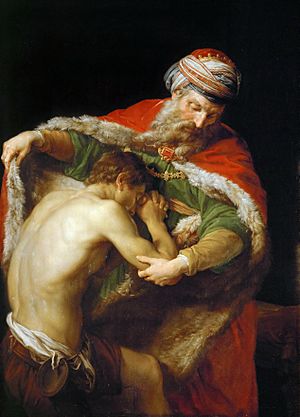Parable of the Prodigal Son facts for kids
The Parable of the Prodigal Son is a famous story told by Jesus. You can find it in the Gospel of Luke, specifically in chapter 15, verses 11-32. This parable teaches us about forgiveness, love, and second chances.
The story is about a father and his two sons. The younger son asks his father for his share of the family money, even though his father is still alive. This was a very unusual request at the time, almost like saying he wished his father was gone.
Contents
The Younger Son's Journey
After getting his money, the younger son leaves home and travels to a faraway country. There, he wastes all his money on foolish things and a wild lifestyle. Soon, a severe famine hits the land, and he has nothing left. He becomes so poor that he has to get a job feeding pigs. For a Jewish person, this was one of the lowest and most unclean jobs possible. He was so hungry that he even wished he could eat the food given to the pigs.
A Change of Heart
Feeling completely lost and miserable, the younger son finally realizes his mistake. He decides to go back home to his father. He plans to tell his father that he is no longer worthy to be called a son and will ask to be treated as one of his father's hired workers. He hopes his father will at least let him work for food and shelter.
The Father's Welcome
While the son is still far away, his father sees him coming. The father is filled with love and pity. He runs to meet his son, hugs him, and kisses him. The son tries to confess his sins, but the father doesn't even let him finish. Instead, the father tells his servants to bring the best robe, a ring for his finger, and sandals for his feet. He also orders them to kill the fattest calf and prepare a big feast. "My son was lost, but now he is found!" the father declares. "He was dead, but now he is alive again!"
The Older Brother's Feelings
Meanwhile, the older brother is out working in the fields. When he comes home, he hears music and dancing. He asks a servant what is happening and learns that his younger brother has returned, and their father is celebrating. The older brother becomes very angry and refuses to go inside. He feels it's unfair because he has always been loyal and worked hard for his father without ever getting a special celebration.
The Father's Wisdom
His father comes out and tries to persuade him to come in. The older brother complains, "I have served you all these years and never disobeyed your commands. Yet you never gave me even a young goat to celebrate with my friends. But when this son of yours, who wasted your money, comes home, you kill the fattest calf for him!"
The father gently reminds him, "My son, you are always with me, and everything I have is yours. We had to celebrate and be joyful, because your brother was dead and has come to life again; he was lost and has been found."
What the Parable Teaches
This parable is the last of three stories Jesus told about things that were lost and then found. The other two are the Parable of the Lost Sheep and the Parable of the Lost Coin. Jesus told these stories after some religious leaders criticized him for spending time with people they called "sinners."
The father's actions in the story show God's amazing love and forgiveness. It teaches us that God is always ready to welcome us back, no matter what mistakes we have made, if we truly repent and turn back to Him. It also shows that God's mercy is limitless and that we should celebrate when someone who was lost finds their way back.
Cultural Impact
The Parable of the Prodigal Son has been a very popular story throughout history. It has inspired many famous works of art, music, literature, and plays. For example, the famous painter Rembrandt created a well-known painting called The Return of the Prodigal Son.
Images for kids
-
James Tissot – The Return of the Prodigal Son (Le retour de l'enfant prodigue) – Brooklyn Museum
-
Stained glass window based on the parable, Charleston, South Carolina
-
Rembrandt, The Return of the Prodigal Son 1662–1669 (Hermitage Museum, St Petersburg)
-
Gerard van Honthorst, 1623, shows a scene with a moral lesson.
-
The Return of the Prodigal Son (Leonello Spada, Louvre, Paris)
See also
 In Spanish: Parábola del hijo pródigo para niños
In Spanish: Parábola del hijo pródigo para niños








